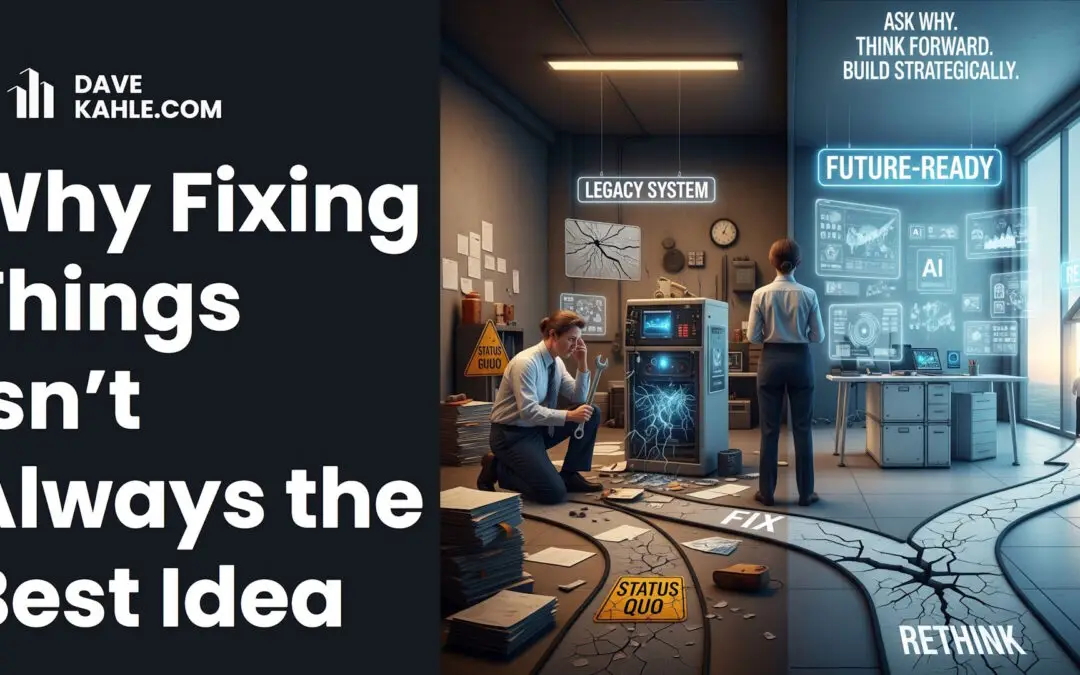Some time ago, one of my clients challenged me to record the 20 most important lessons I’ve learned in my 30 years of consulting experience. After a great deal of reflection, I eventually came up with 25. This is one. Fixing things isn’t always the best idea. In our rapidly changing world, instead of restoring the status quo, we need to build for the future.
Here’s a couple of examples. Let’s say you’ve determined that a piece of software is becoming unreliable. You could get the vendor to upgrade it, or you could look at the applications for which you use the software, and search for something that will serve you for the next few years. Instead of fixing what you have and returning everything to the status quo, you focus on gearing up for the future.
Or, one of your salespeople has left for greener pastures. You could, in a knee jerk reaction, begin to search for someone to replace him/her, or you could take a deep dive into the dynamics of the customers, the territory, your future products, and determine that maybe a replacement outside salesperson is not the necessarily the best move. Instead you invest in some additional software, and expand the role of one of your inside salespeople.
In both cases, while you were tempted to just fix the situation and return everything to the status quo, instead you took advantage of the need for change by looking to the future and putting in place a solution that is designed for the future, not the past.
In both cases, the decisions to buy the old software or to hire the departed salesperson were made in an earlier time, by different people, for a set of circumstances that have long disappeared.
Over my 30-year career, I’ve worked with over 500 sales organizations. In all of that, I’ve concluded that very few policies, procedures or people have been strategically put in place to deal effectively with the future. Most of those things are vestiges of times past, put in place by a previous generation of people for a long-gone situation.
When we are faced with a need to take urgent action because something is broken, our knee jerk reaction is often to replace the offending decision with another of the same type. In so doing, we hinder the company’s advancement and miss an opportunity to move forward.
Because the fix-it mentality is so ingrained in most of our psyches, we need to face the next major maintenance with a mindful discipline. It requires a change in mind-set. Suppose we look at everything that needed serious maintenance as an opportunity to put in place a strategically forward-looking new solution?
Here’s a simple three -step format that will help capture the future solutions.
1. Articulate the issue as clearly and specifically as you can. For example: “We’ve just lost one of our outside salespeople. The territory is now open. We need to fill the territory.”
2. Ask “Why?” two or three times. So, “Why?”
Answer: “We can’t have an open territory for long.”
“OK, Why?”
Answer: “We need to continue to serve our customers and meet our sales goals.”
“So, what you really want is a way to serve your current customers, and make sure that your key product lines are presented appropriately?”
3. At this point, you may have uncovered the real question, so you edit it a bit and write it down: “Is there a way to serve our current customers and present our key products that that is less expensive, or more effective than taking the risk on another outside salesperson?”
While coming to the actual solution may take a bit more time, you have identified the forward-looking action. The way is now clear for a wider range of creative solutions. You could, for example, create a web portal for each of your current customers, on which you maintained their pricing, as well as the status of every order and receivable. That might even take better care of them than a salesperson who called in person every few weeks. Maybe you could schedule video lunch-and-learns in which you have product experts present the new products. You could set that entire system up in a month or so for far less than the cost of a few months of a replacement salesperson. Now, I’m not proposing that is the solution, only that it is an example of the kind of creative solution that can follow your question.
In this little 10-minute thinking exercise, you have vaulted from a knee-jerk reaction to a strategic focus on the future. This will work on almost every ‘fix-it” type of situation that is big enough and impactful enough to warrant a little bit of out-of-the-box thinking.
In an era where AI threatens to replace millions of white-collar workers, those who survive and prosper will learn to think better than their colleagues. This is an example of one of the dozens of applications in our Mind Software series of training programs designed to help you think better. Learn more here.
To access all of Dave’s Christian Business Insights content FREE – posts, articles, podcasts, and videos https://davekahle.substack.com/s/christian-business-insights
Related Resources



